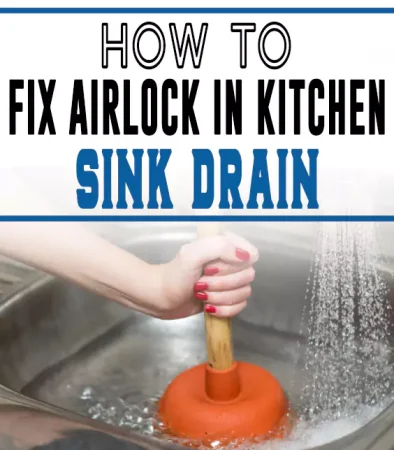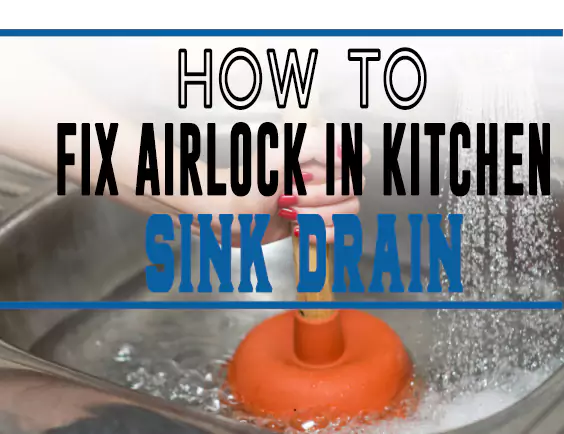Is your kitchen sink draining water slowly while producing bubbles or making gurgling noises? Here’s how to fix an airlock in your kitchen sink drain that might be causing it.
The drain could be airlocked due to a lack of proper ventilation in the pipe systems. If this is the case, you might be wondering how to fix the airlock in the kitchen sink drain.
If you fail to fix the problem early on, it could lead to severe blockage. And in the end, you would have to replace the drain system, which can be expensive.
Nothing to worry about, though. If you understand the causes of the airlock, it should be easy to clear the trapped air inside the drain. Besides, there are many solutions available to try out, including installing an air admittance valve.

How to Fix Airlock in Sink Drain
Clearing Out Blockage
In some cases, you can get the air out of the sink drain by only clearing out a blockage in the conduit.
Step 1: Get the Right Tools
You need some of the same tools required to unclog a drain. These include a plunger and drain snake, or auger.
Step 2: Run Hot Water
Next, remove your sink’s drain stopper or cover and clean any clogs. After that, run boiling water down your kitchen sink several times. Then, run the water to observe if your sink is still draining slowly or if there are gurgling noises.
Step 3: Use a Plunger
If the problem is still there, get a plunger and apply pressure to the drainpipes of your sink. Repeat this severally as it may partially help remove air from drain pipes.
Step 4: Take the Drain Pipes Apart
Get underneath your sink, and disassemble the drain pipes, including the P-trap. Then, clean the piping and the trap. Next, feed your drain snake or drain auger into the drain pipe and rotate it slowly.
Then, remove the snake before reassembling the drain pipes. Lastly, run the water to test for drain flow.
Install Air Admittance Valve (AAV)
If the first method does not work, you should check your drain’s air admittance valve.
Here is how to get the air out of the kitchen sink drain via this method.
Step 1: Look for the AAV
The job of the air admittance valve is to let air inside the drain system. This helps prevent negative pressure in the drain, which could lead to an airlock.
However, not all kitchen sink drains have an air admittance valve. If your drain already has the valve, you simply remove it. Then, clean it to get rid of debris. Next, put the valve back and test your drain’s flow.
Step 2: Get a New AAV System
If you don’t get the desired results after cleaning the valve, you will have to install a new one. This also applies if your sink drain does not have a valve.
Step 3: Installing the New Air Admittance Valve
Get some pliers and loosen the nuts holding the drain trap. Next, remove the drain trap. Then, fit your AAV in the drain pipe between the trap and the wall in a vertical position.
Make sure the valve is at least 4 inches high. Once the air admittance valve is in place, turn on the water in your sink and listen for gurgling noises.
Unclogging the Vents Pipes
Your sink’s drain line usually attaches to a sizable pipe, which then connects to a vent pipe. The vent pipe permits trapped sewer gasses to escape out of your house.
Here is how to unclog the vents and clear a slow kitchen sink drain.
Step 1: Locate the Vent Pipe
You will find the vent pipe on the rooftop more or less over the room where your kitchen sink sits.
Step 2: Clear any Debris
At the vent opening, clear out all the debris you can spot. Then, use a flashlight to locate more clogs down the pipe.
Next, get a drain auger and push the waste out of the vent pipe. Alternatively, you can spray water into the drain to clear the clogs deep inside the vent.
Can a Sink Drain Get Air Locked?
Yes, and interestingly, the airlock in the kitchen sink drain pipe may appear similar to a blockage.
However, an airlock usually occurs when a pocket of air in the piping has nowhere to flee. As a result, this creates pressure, which prevents the normal flow of liquids in your sink drain.
In most cases, this happens because your kitchen sink drain’s wastewater is usually discarded into the sewer. And as it turns out, airlocks typically occur anywhere within the sewer line. Now, while sometimes an airlock can fix itself, the risk is not worth taking.
What Causes Air Lock in Sink Drain Pipe
Improper Ventilation
Sometimes, the pipe systems may lack proper ventilation. Or, the vent pipes may be having a blockage. All this can lead to the airlock since the trapped air has no way of escaping.
Leaks
A small leak in your sink drain may let in the air inside the pipe. And if this air has no way of clearing out, you will end up with an airlocked sink drain pipe.
Pressure Imbalance
Your hot-water pipes are more likely to experience air lock than their cold-water counterparts. This is because hot-water sink drain pipes have lower pressure than cold water counterparts.
Water System Maintenance
During maintenance of your water systems, the plumber may cut off the water supply for some time. During this time, air may enter the system, causing an airlock in the sink drain pipe.
Defective or Loose Valve
The valves along your sink drain pipes can suck in the air if they are defective or loose. Once the air gets trapped inside the piping, it may lead to an airlock.
Signs of Airlock in Kitchen Sink Drain
Sluggish Drain
One way to know if there is air trapped in drain pipes is the sink draining slowly. This happens because the drain is only partially obstructed by air.
Gurgling Sounds
If you hear gurgling noises while draining the kitchen sink, it is a sign that the drains have ventilation issues. The sounds occur when air is trapped inside the drain due to poor ventilation.
Bubbles
Additionally, you might notice bubbles coming up as your dishwasher is draining. This happens when a pocket of air is trapped inside your kitchen sink drain.
Stinking Drain
You see, kitchen drains feature a trap for holding small amounts of water once you’ve drained the sink. This helps prevent sewer odors from escaping. If air is trapped inside the drain, the trap can dry up, causing dreadful sewer odors in your kitchen.
Leaks
Leaks can cause a kitchen sink drain to get an airlock. So, when you suspect your drain has an airlock and you spot a leak, the diagnosis could be accurate.
How to Prevent Airlock in Water Pipes
Install Vents
Water pipes need vents to allow pressure to escape. Without vents, it may be hard for water to move through the drain efficiently.
More so, any air that gets inside the plumbing system may not have a way to break free. Consequently, this may lead to an airlock.
Stopping Leaks
The best way to stop leaks is to ensure there are enough seals in place along your water pipes. Also, you should always fix leaks as soon as they occur. Because if not, air will find its way inside the water pipes and cause an airlock.
Install Vent Covers
Clogged vents in your plumbing system can cause an airlock when trapped air lacks a way to flee. Using a vent cover can help prevent clogging in the future.
Ensuring Proper Water Flow
You must ensure that water in the pipes flows smoothly and at high pressure. This way, if there are air bubbles inside the tubing, the water can transport them to the end.
Can Air in Pipes Cause Low Water Pressure?
Absolutely. This happens when the air is trapped at the highest point in your water pipes. Unfortunately, if the drain has no proper ventilation or perhaps the vents are clogged, the air will become trapped. And with no way of escaping, the air bubbles may interfere with standard water pressure.
Another thing is that air in water pipes may lead to other issues like rust and corrosion. With time, this may lead to low water pressure because of the weak piping system. Fortunately, there are many ways to flush air out of water pipes.
Key Takeaway
Besides the faucet, your sink drain can also get airlocked. This may happen when the pipe systems lack proper ventilation due to blocked vent pipes. Also, the problem may arise because of pressure imbalances, leaks, or defective valves.
However, sometimes the issue may not be an airlock but a blockage. This is unless your sink drain is draining slowly, experiencing bubbles, or gurgling noises.
The good news? Fixing an airlock in the sink drain is not as difficult as you might think. You just need to clear out any blockage, install an air admittance valve, and unclog your pipes. In addition, you could add vent covers to prevent blockage and apply enough seals to avert leaks.

